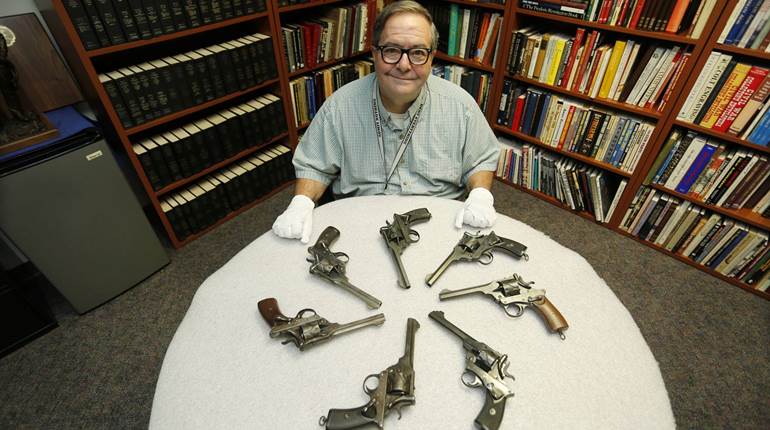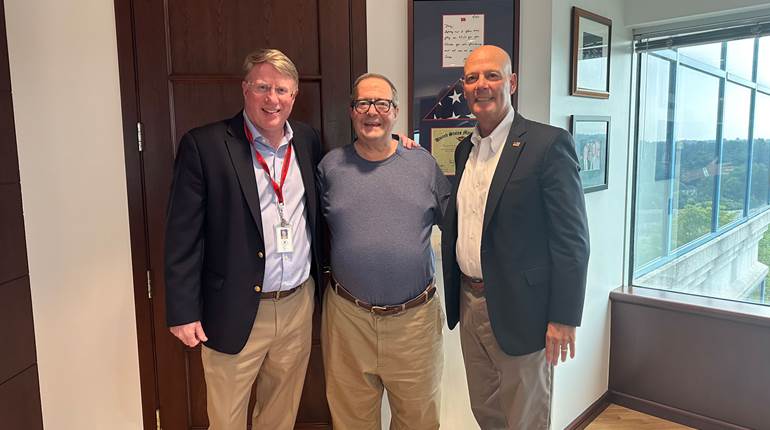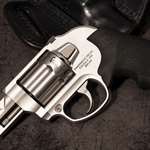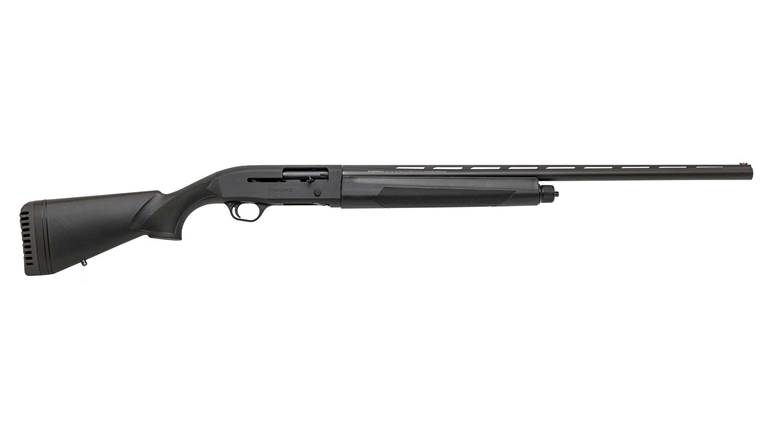
 To understand the Winchester story, you first must understand the Smith & Wesson story. In 1848, Walter Hunt designed and patented a hollow-based bullet that was packed with propellant. He envisioned a rifle that could hold a number of these “Rocket-Ball” cartridges in a tubular magazine and could be shot by simply working a lever that would bring a new round into battery, ready to fire.
To understand the Winchester story, you first must understand the Smith & Wesson story. In 1848, Walter Hunt designed and patented a hollow-based bullet that was packed with propellant. He envisioned a rifle that could hold a number of these “Rocket-Ball” cartridges in a tubular magazine and could be shot by simply working a lever that would bring a new round into battery, ready to fire.
He enlisted the help of gunsmith Lewis Jennings to help design a rifle that would handle this new style of cartridge. Jennings and Hunt then conveyed the patents to Courtlandt C. Palmer to handle the manufacture and sale of what was thought to be a magnificent new advancement in firearm technology.
Palmer took the design to Robbins & Lawrence of Windsor, Vt., to do the manufacturing. He hired Horace Smith (1808-1893) to assist with the manufacturing details at the factory. It was there that Smith may have first met Daniel B. Wesson (1825-1906), who was supervising the manufacture of pepperbox revolvers.
After the abject failure of the Hunt-Jennings-Palmer Rocket-Ball rifle, both Smith and Wesson found themselves at Ethan Allen’s firm of Allen, Brown & Luther in Worcester, Mass., working for the rifle barrel manufacturer.

The idea of a repeating firearm that fired self-contained cartridges was not lost on the two New Englanders. Wesson had begun to develop a Flobert-style cartridge pistol by 1851 and, by 1852, the two had formed a partnership to improve the Jennings firearm design incorporating the self-contained rimfire cartridge. In 1854 they took out a patent on the new cartridge design and produced around 250 handguns based on the design and using the new cartridge.
Looking for capital to manufacture the pistol, Smith and Wesson looked to Smith’s former employer, Courtlandt C. Palmer, to seek financing. It was a wise move, as Palmer held the patents on Hunt and Jennings’ work in the same area and this helped circumvent any possible patent infringements the two might have encountered down the road. The Volcanic Arms Co. was formed, and J.W. Post obtained stockholders to keep the Norwich, Conn., factory running. Among those who bought into the company was a shirtmaker named Oliver Winchester (1810-1880) of New Haven, Conn.
Problems with the Wesson-designed Flobert cartridge system forced the inventors to make improvements to Hunt’s Rocket-Ball design instead. The result, the Volcanic cartridge, had its own set of hurdles to clear before it became evident it would never work well within the mechanism Jennings designed—even with improvements made by Smith and Wesson.
Under 2,000 small- and large-frame repeating pistols and rifles were completed by the Volcanic Arms Co. before poor sales and crippling mechanical failures forced Smith and Wesson to abandon the enterprise to their majority stockholder, Oliver Winchester. Within the next year, Smith and Wesson, still wanting to make a go of a repeating pistol, wrote to enquire about Rollin White’s bored-through cylinder patent and the rest, as they say, is history.
Oliver Winchester was left owning the control of the fledgling Volcanic Arms Co. for which he was a majority shareholder and corporate vice president. In a shrewd move of corporate gamesmanship and financing, he then forced the company into bankruptcy. He was able to purchase all the company’s assets at the bankruptcy auction for about $40,000, and with William Story and J.W. King, formed the New Haven Arms Co. in 1857.
The old Volcanic Arms Co. had enough parts and nearly finished arms to make another 2,000 functioning guns, which were marketed and sold. The next year, 1858, Winchester hired a talented gunsmith named Benjamin Tyler Henry (1821-1898) to become the factory supervisor to oversee the completion of new-old-stock Volcanics.
Henry was perplexed at the idea of a projectile with a propellant base and looked to the self-contained cartridge design of Smith and Wesson, whose patents Winchester had picked up for a song at the earlier auction.

A new set of eyes on the problem yielded historic results when, in 1860, Henry patented the .44 rimfire cartridge and made improvements to the feed and extraction elements of the Volcanic rifle design. Winchester immediately knew that to successfully sell the rifle, he needed to manufacture the ammunition that fed it. He immediately set out and began an ammunition factory to keep up with the demand that the 16-shot Henry repeating rifle would command.
Many historians have cited Union Gen. James Wolfe Ripley’s (1794–1870) reluctance to order mass quantities of breechloading rifles and carbines as a nearsighted effort to keep expenses down on firearms and ammunition. But his tenure as chief of ordnance ended in September 1863, and a month after he left office, the U.S. Army purchased 1,700 Henry rifles. They cost $42 each and an additional 1,000 rounds of .44-100 rimfire ammunition cost an extra $17.50.
A total of 13,000 Henrys were manufactured before production ceased in 1866. The factory was running at full capacity and the New Haven Arms Co. was selling them as fast as it could make them. The real problem that limited military purchases was the fact that the rifle cost four times the cost of a Springfield rifle-musket and the .44 rimfire round was actually more suited for pistols than a full-power rifle cartridge then thought needed in infantry combat.
Benjamin Tyler Henry’s contract with Oliver Winchester and the New Haven Arms Co. came to an end in 1866, and he left the firm. Winchester reorganized and renamed the company the Winchester Repeating Arms Co. and rolled out an improved version of the lever-action repeating rifle, the Model 1866 chambered in the same .44-100 rimfire round as the Henry.
Scholars who wish to know everything there is to know about the 150-year-old Winchester Repeating Arms Co. should seek out Herbert G. Houze’s Winchester Repeating Arms Company: Its History & Development from 1865-1981 (1994, Krause Publications).
Here, we will only hit some highlights of this venerable and historic firearms manufacturer that has contributed to the evolution of firearm design and manufacture—as well as contributing to the industrial and military might of this nation.
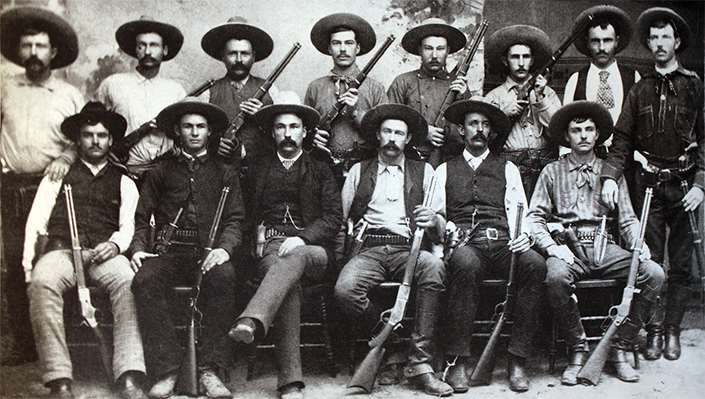
The Era of the Lever Action
With the introduction of the 1866 rifle and carbine, Winchester, with the talents of Nelson King, improved upon the drawbacks soldiers encountered with the Henry rifle. Primarily, the new design featured a side-loading gate that eliminated the muzzle feed tube of the Henry, and made it practical to put a wooden fore-end on the gun to prevent the burning of one’s hands while firing the gun and eliminated feed interruptions. Twin firing pins eliminated most of the misfire problems that the single-striker Henry had. More than 170,000 Model 1866 rifles were produced between 1866 and 1898.

The Model 1873 has often been called “the gun that won the West.” “Winchester ‘73” (1950), starring Jimmy Stewart, and countless more movies and television shows, have helped solidify that image in the American psyche. And the numbers are there to support the claims; more than 720,000 were produced between 1873 and 1919. Today it is still a staple of every cowboy action shooting match, and it is popular in cartridges such as .45 Colt, which wasn’t even offered in the gun originally.

Winchester next introduced the beefed-up 1876 “Centennial” Rifle, which came chambered in cartridges considered more suitable for big-game hunting, and more than 60,000 of these big guns were made between 1876 and 1897.
The Browning Influence
Things changed a decade later when, six years after the death of Oliver Winchester, John M. Browning entered onto the Winchester scene. He designed a single-shot rifle Winchester produced in 1885, and he returned a year later with his first repeater: a streamlined, large-frame lever-action that would be known as the Model 1886. This big-game gun enjoyed a production run that lasted until 1935 with some 160,000 produced. Theodore Roosevelt was so enamored with his 1886, and used it so often, that he sent it back to Winchester for refurbishing at least five times.

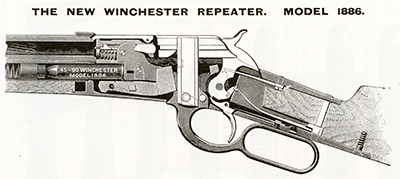 Browning followed up with a streamlined modernization of the 1873 (still in production) with his Model 1892 (about 1 million produced between 1892 and 1941) and, with the advent of smokeless powder, the first high-powered, small-bore lever-action, the Model 1894, which is still in production with more than 7 million produced. To give you some perspective, that’s a million more than the total U.S. M1 Garand production.
Browning followed up with a streamlined modernization of the 1873 (still in production) with his Model 1892 (about 1 million produced between 1892 and 1941) and, with the advent of smokeless powder, the first high-powered, small-bore lever-action, the Model 1894, which is still in production with more than 7 million produced. To give you some perspective, that’s a million more than the total U.S. M1 Garand production.
Advancements in smokeless powder led to the development of the spitzer, or pointed-nose, cartridge. As the French found out with their 8 mm Model 1886 Lebel, a tubular magazine was not the most practical conveyance where the pointed nose of one round was resting on the primer of the next round in the magazine. Riding to the rescue once again, John Browning developed the lever-action Model 1895 that incorporated a box magazine in which the cartridges were stacked vertically. In .405 Win. Theodore Roosevelt deemed this rifle “The Medicine Gun for lions,” and it quickly replaced the Model 1886 as TR’s favorite hunting rifle. He even had a carbine version with him during the Cuban campaign of 1898.
Browning provided Winchester with most of its successful arms designs. In addition to the 1885 High Wall and Low Wall single-shots, Browning also licensed the Model 71 lever-action rifle, the 1887 lever-action shotgun, the Model 1893 and 1897 pump-action shotguns, the Model 1890 pump-action .22 rifle and the 1900 bolt-action .22 rifle. Thomas C. Johnson of Winchester used Browning’s designs of the 1893 and 1897 pump-action shotguns to develop the wildly successful Winchester Model 12. How successful? More than 2 million were made.
Browning’s work in the field of full-automatic firearms resulted in the development of the Model 1917 water-cooled, belt-fed machine gun, as well as the Model 1918 Browning Automatic Rifle (BAR), the latter of which was also manufactured by Winchester.
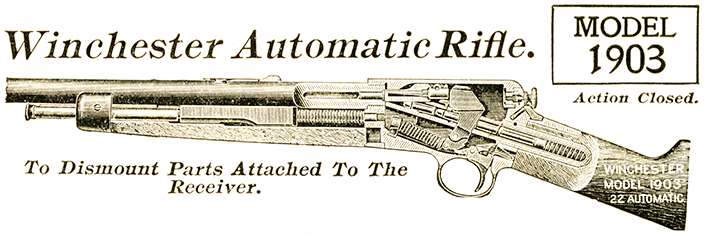
A Product For Every Need
Winchester was the unrivaled powerhouse of rifle and carbine manufacture in the 20th century. Literally millions of Winchesters were manufactured for nearly every possible need up to America’s entry into World War II. If you desired a .22 rimfire for plinking or small game, the pump Model 1890, semi-automatic Model 1903 (above)and Model 63 are all considered classics.
For target shooting, the bolt-action Model 52 is considered one of the best in its class. The bolt-action of the Model 54 was the basis for the legendary Model 70, called the “Rifleman’s Rifle,” which became a staple of hunters across the globe as well as the preferred rifle of U.S. military sharpshooters well into the 1960s.
The Model 1907 in .351 Winchester Self-Loading became one of the first semi-automatic rifles favored by law enforcement personnel, establishing the semi-automatic as a practical rifle for civilian use.
Winchester was eager and capable of answering the country’s need for arms in both world wars by producing hundreds of thousands of Pattern 1914 .303 British “Enfields,” then U.S. Model 1917s in .30-’06 Sprg. and the first non-Springfield-Armory-made U.S. M1 Garands. And using David Marshall Williams’ short-stroke piston, the company developed and manufactured the M1 carbine. Browning M2 .50 BMG machine guns, as well as a wide assortment of other full automatic light and heavy machine guns, rolled off the Winchester factory floors to arm not only our fighting forces but those of our allies involved in the conflict as well. After World War II, Winchester further contributed to the national defense as one of the makers of the “U.S. Rifle, M14, 7.62,” some of which are still in service today.
Post-War Depression
Following the 24/7 output of products during the Great War (1914-1918), Winchester saw a depression in sales as well as severe financial strains as bonds and notes that were taken to expand production during the war, came due. Sales fell to an average of 150,000 firearms of all types annually during the inter-war (think Great Depression) period. Winchester tried to diversify and expanded into manufacturing basketball hoops, flashlights, safety razors and saws, just to name a few items produced. These items now bring premiums from collectors who wish to add to their Winchester arms collections.
In 1931, John Olin (1892-1982) of the Western Cartridge Co. purchased Winchester and in 1935 merged the two into Winchester-Western. He championed the Model 52 bolt-action .22 as well as the Model 21 side-by-side shotgun, considered to be one of the finest American double-barrel shotguns ever made. Combining the ammunition and firearms manufacturer into one was a move that saw sales double during the latter part of the 1930s, considered the hardest years of the Great Depression.

Pre-'64 Versus Post '64
Olin managed the helm of Winchester-Western for 30 years and then retired, at which point he assumed the role of honorary chairman of the executive committee in 1963. Faced by mounting competition from Remington, and entering a new era of manufacturing techniques, the new management of Winchester revamped factory production methods in 1964. Thus began production with cast and stamped parts where forged steel had been used before. Hand checkering was out; pressed checkering was in. This resulted in a noticeable change in quality and gave rise to collectors seeking out guns, such as the Model 70 and Model 94, made prior to the 1964 changes. It was a decision that seriously wounded the Winchester brand—one from which some say the company never fully recovered.

In 1980, Olin Corp. (which makes billions of cartridges every year bearing the Winchester name and owns the name) sold the New Haven manufacturing plant to the employees. Manufacture of Winchester firearms continued there under license with the name of U.S. Repeating Arms Co. (USRAC). Six years later, USRAC was bought by Herstal Group of Belgium (owners of Fabrique Nationale and Browning Arms Co.), and in 2006 the New Haven, Conn., factory—the geographic birthplace of the Henry, Model ’73 , Model ’94 and countless American classic arms—closed, ending 140 years of legendary arms production.
Current firearms bearing the Winchester name are manufactured for Browning under license from Olin by FN in Belgium, Portugal and by Miroku Corp. (est. 1893) in Japan, which has made classic John Browning-designed Winchesters for decades under both the Browning and now Winchester names. The Model 1866, the “Yellow Boy” with King’s patented loading gate, introduced to commemorate 150 years of Winchester guns, is made there.
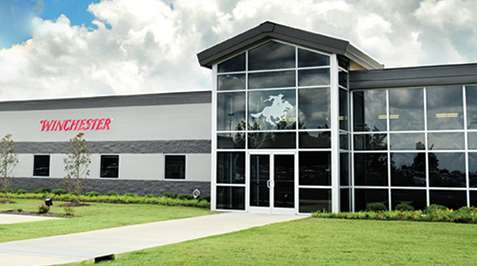
Although Winchester rifles and shotguns are no longer made in Connecticut (although some Winchester barrels are made by FN America in its South Carolina plant), pump-action shotguns, over-unders, semi-automatics, bolt-actions and, of course, lever-actions are part of a worldwide brand that is today’s Winchester Repeating Arms Co.

The Model 1866 Is Back
Winchester last produced the Model 1866 in 1898, but this year it is back and being made for Winchester Repeating Arms Co. by Miroku. Of course, Model 1866s have been made by Uberti in Italy for Navy Arms and others since the 1960s, but this marks the first time a Model 1866 has worn the Winchester trademark since the Spanish-American War.
Winchester Repeating Arms Co. is offering limited-edition .44-40 Win. guns—commemoratives for the 150th anniversary—with blued, 24" full-octagon barrels, and blued loading gate, while the polished-brass receiver is engraved in the Ulrich-style with tasteful scrollwork, the Winchester “horse and rider” logo with the stylized WRA trademark. The buttplate, lifter, fore-end cap and lever are also of polished brass. The straight-grip stock is grade V/VI walnut, as is the straight rifle-style fore-end. The price is $3,330. For more information, go to winchesterguns.com.
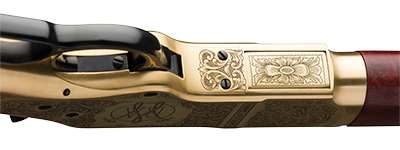
Winchester is also offering a series of 10 pre-production rifles from the “One of Five Hundred” Model 1866 “Yellow Boy” commemorative rifle collection with custom embellishments and identification through Baron Engraving. Each rifle will also come with a special box of commemorative ammunition and the 150th anniversary collectible medallion.
The rifles have been allocated to various industry and conservation organizations—including NRA—to help raise funds in support of the shooting sports and our hunting heritage. “This is a very unique series of collectible firearms and ammunition that represents the Winchester brand and our 150 years of legendary excellence,” said Winchester’s Brett Flaugher. “We are very proud to help raise awareness and dollars through our 150th celebration in 2016 that will benefit the hunting and shooting sports industry.
“This is our opportunity to share with the world the history of Winchester, but also the story of a brand at the forefront of engineering excellence and new technologies in the development of ammunition and firearms.”
Mark A. Keefe, IV, Editor In Chief
Commemorating 150 Years of An American Legend
Of course, Winchester has been in the ammunition business as long as it has been a gun company. The landmark Model 1866 lever-action would have been useless without the .44 rimfire cartridges it chambered. Although the ammunition and gun businesses split up years ago, the two entities—Winchester Ammunition and Winchester Repeating Arms Co.—have come back together to work hand-in-hand to celebrate 15 decades of Winchester ammunition and firearms.
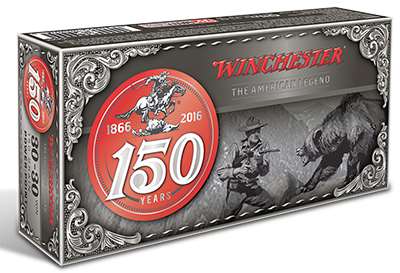
“Winchester is a brand at the very core of the shooting sports and hunting heritage, and it’s humbling to know we have helped write history,” said Brett Flaugher, vice president of marketing, sales and strategy. “With so many reputable companies in this industry today, we are fortunate to have such a rich legacy that we can share with our customers, our families and those who appreciate our contributions. Our brand is built on integrity, hard work and a deep focus on its most loyal customers. With a deep emphasis on innovative products, the Winchester brand remains one of the most recognized and respected brands around the world.”
And while a commemorative rifle might not be in the budget this year, Winchester is offering .44-40 Win., .270 Win., .30-30 Win. and 12-ga. shotshells with black-and-silver embossed packaging highlighting some of the great artwork from Winchester’s past—including some pieces used in these pages. My favorite is Philip R. Goodwin’s “Close Encounter” on the box of 150-gr., .30-30s.
Winchester went to considerable effort to chronicle its story with an online timeline featuring photos, facts and videos with my friends Ron Spomer and Ashley Hlebinsky, among others. Spomer, of course, is an outdoor writer and host of “Winchester World of Whitetail,” while Hlebinsky is the curator of the Cody Firearms Museum at the Buffalo Bill Historical Center in Cody, Wy.—that’s where the Winchester collection of guns and ephemera resides today. Videos on guns such as exhibition shooter “Plinky” Topperwein’s Model 1890 to the M1 Garand intended for Gen. George S. Patton are just a snapshot of what is covered, and be prepared to spend some time on the timeline as it is worth it. You can visit it yourself at winchester150th.com.
Mark A. Keefe, IV, Editor In Chief














